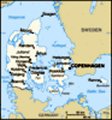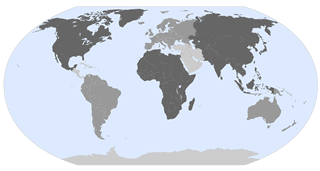Advertisement
Published: July 19th 2014
Copenhagen Denmark - 16-19 July 2014
After leaving Odense, we travelled over the Great Belt's Bridge to Zealand, another section of Denmark. This bridge is extraordinary (called Storebaelts Forbindlesen by locals) as it covers 18km which is even longer than the Oresunds Fixed Link to Sweden. The bridge has 2 spans and in the middle is a manmade island, plus a tunnel. It was finished in 1998. Taller and three times longer than San Francisco’s Golden Gate Bridge, Denmark’s Great Belt Bridge is a landmark engineering achievement and a vital link for people traversing Denmark.
The Great Belt Bridge has about 200 employees to ensure the daily operation. The toll for the bridge is about $35 AUD.
Again, Kerrie's Danish friend, Tea, had asked her friends if they would be interested in meeting us and many of her friends said yes. One of these friends were Henrik and Mette in Copenhagen. They had offered their apartment which was in central Copenhagen as they were going to Portugal for 3 weeks. What a very generous offer. We therefore took up the offer and after excellent email communication, our GPS took us right outside their address. We had arrived a
day earlier than expected, but after a call to Henrik who were in the beautiful SW corner of Portugal, we caught up with Mette's sister after 6.00pm.
While we were waiting, we got our bikes out and road to see the famous Little Mermaid and the Kastellet Citadel, which is a castle with a full-on star-shaped mote and ramparts around it, and numerous piers for small ferries and large cruise ships. It was a beautiful day also, so we saw a lot of people running around the ramparts, including several groups. We also saw the largest fountain (Gefion) in Copenhagen.
After that, we rode around the district of Ostebro where Mette and Henrik's apartment was, to get to know the area. We also spotted a Laundromat and did some washing while we were cycling around.
We then met Mette's sister after she had finished work, who gave us the keys. She was wonderful in further orientating us to the apartments. It was fantastic to have a home to stay in and it was only a 10 minute bike ride to central Copenhagen. We felt very lucky to have this opportunity. The apartment was very comfortable and we
hope that one day, we meet Mette and Henrik, perhaps in Australia, to return the favour. (thank you Tea...again)
The next day, we woke to a magnificent day of 20 degrees, clear blue sky and a fantastic map of the city, complemented by an excellent 'mud-map' prepared by Henrik.
On our bikes, we first headed for Centrum, The Medieval city - a place of many names, but it is the historical heart of Copenhagen, dotted with church spires, historic buildings, narrow alleys and excellent shopping. The areas in the city we visited over the 3 days we were in Copenhagen were:
Norrport:
We rode our bikes near the Botanic gardens and discovered Rosengarden and Rosenborg Palace which is a small but pretty renaissance palace, surrounded by the lovely King's Garden which is one of the most lively parks of the city. The palace both serves as a museum of Royal history and as a home for the crown jewels which are on display in the catacombs beneath the castle. We visited them both. A closed-off wing of Rosenborg serves as barracks for the Royal Guard, and every day a detachment marches through the Copenhagen
city centre between Rosenborg and Amalienborg for the changing of the guard. When we were in the city, we saw their parade. Unusual for a well-founded democracy, the palace that houses the parliament, Christiansborg, is also a royal palace. It is usually possible to visit the Royal reception rooms, stables and the old court theatre but we visited the foyers of these areas.
Christianshavn:
Originally laid out as a working class neighbourhood 300 years ago, it is now a thriving area notable for its many canals. The
Freetown of Christiania is situated in the eastern section of Christianshavn, along with the old naval area, turned trendy. It is an amazing area with psychedelic painting of buildings, alternate markets, unusual art and a very strong smell of marijuana which is sold extensively. Oh the free spirit of the 70s continue!!
It is a self-governing community that has been squatting on an old naval area since the seventies. Their inventive, brightly coloured, home built houses are spectacular, as is the relaxed atmosphere, albeit with some problems related to the selling of mild drugs in one street, the "Pusher Street" (no photography allowed there!). However, Christiania is overall one
of Copenhagen's most unique attractions. We strolled through the entrance area, along the northern moats parallel to Refshalevej and across the Dyssebroen wooden bridge eastwards, and experienced the rural aspects of the place.
In the northern part of Christiana is the Opera House which is across the Yderhaven from the Royal Family's Palace (Amalienborg).
After visiting the Palace, we visited the Danish Design Centre with temporary and permanent exhibitions, showrooms, and workshops relating to the world of Danish design, in a building designed by famous architect Henning Larsen. Denmark is world-famous for its design tradition, and while the term Danish design has been devalued over the years due to much misuse, it is still a world-recognized brand. We had a beautifully presented lunch here, which suited the environment we were in - a very unusual, stylish, fresh salad and gaspachio (a cold tomato soup) with red onion, bacon and parsley...beautiful.
We then rode along the canal, past Tivoli, the big fun park in Copenhagen then through Norrebro. We stopped in at the Planetarium for ice-cream and coke on the way back to home.
On the way into the city, we stopped off
at a bike shop as Tom's bike needed new bearings. He hired a replacement bike while they fixed it so on the way home we picked up the repaired bike. It is now really riding well.
Vesterbro:
This district has evolved tremendously in recent years and is now one of the hippest places to live, with cafes and bars dotted along its main artery, Istedgade.
Frederiksberg:
A small town which originally formed around Frederiksberg castle, this area is still a separate municipality. Literally surrounded by the City of Copenhagen, it has preserved a special conservative, upscale feel.
Norrebro:
One of the most vibrant parts of Copenhagen, especially along the main artery, Nørrebrogade, with a mix of immigrants, students, and original working-class Nørrebro-inhabitants.
We also found the Round Tower or Rundetårn as the locals call it, and we climbed this unique 7.5-turn helical corridor leading to the observation platform which is one of Copenhagen's most iconic buildings. It offered excellent views and is smack in the middle of the city.
That night, we stayed in the city centre to have dinner. There were plenty of
restaurants to choose from. The evening was a beautiful temperature although I had to put a light jumper on in the breeze.
Nyhavn:
We particularly loved this area with its cafe and restaurants lining the Nyhavn canal (which connected the Kongens Nytorv to the harbour). In the beautiful sunshine, we selected one of the restaurants and sat down and had a couple of local beers while we watched everyone go by. This is the area where the canal boat trips leave from. we did not do one of these trips has we had covered the same area....and more, on our bikes. It was such an easy city to ride our bikes around in, with designated bike paths, bike path lights and blue pained paths for bikes at intersections. Oh it would be fantastic to have our cities in Australia set up for bikes like this.
This was also the haunt for sailors and writers, including Hans Christian Anderson, who lived here much of his adult life.
On our second day in Copenhagen, we visited Amalienborg Palace. The four identical classicist palaces of Amalienborg, make up the main residence of the Danish royal family. The
octagonal courtyard in the centre is open to the public and guarded by the ceremonial Royal Guard. The relief takes place every day at noon and is a highlight for any royalist visiting the city. The Queen was not home so they conducted a 'cut down version' of the changing of the Guards. There is also a small royal museum on the premises, with beautiful furniture and displays of finery as seen by my photos. We really enjoyed this.
We wanted to visit the Ny Carlsberg Glyptotek but it was closed "due to water problems".
With our regular mid-morning coffees, our lovely lunches, the opportunity to wander through the pedestrian malls, and seeing all the special sites of the city, the safety in riding our bikes in a big city (which has over 1.9 million people by the way) we felt Copenhagen was a very special city and one that we thoroughly enjoyed. To top it all off, the weather was magnificent and we were living in a lovely apartment - thank you again to Mette and Henrik.
Advertisement
Tot: 0.118s; Tpl: 0.015s; cc: 17; qc: 31; dbt: 0.0728s; 1; m:domysql w:travelblog (10.17.0.13); sld: 1;
; mem: 1.2mb
























